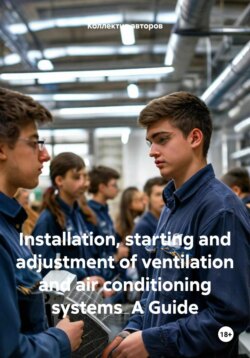Читать книгу Installation, starting and adjustment of ventilation and air conditioning systems A Guide - - Страница 15
Chapter III. Equipment of air ventilation systems
3.9. Noise suppression equipment
ОглавлениеThe noise level generated by ventilation systems is an essential criterion of ventilation quality. The sources of noise in ventilation installations are fans and electric motors, as well as the movement of air in the ducts and its exit from the holes. Two types of noise are considered: aerodynamic and mechanical.
The reasons for the appearance of aerodynamic noise in fans are: the formation of vortices and their periodic disruption from the blades of the impeller, local air flows at the entrance to the wheel and at the exit from it, leading to unsteady flow around the blades of the wheel, perturbation of the medium by rotating blades. Mechanical noise occurs in bearings, in the drive, in the installation sites (fasteners) of the ventilation unit on building structures, etc. The degree of noise increases with insufficient balancing of the fan impeller.
Of all the sources of noise generation, the dominant ones are fans that create aerodynamic noise. The noise generated by the ventilation system can be reduced by the following measures: installation of fans with the most advanced acoustic characteristics, in particular, fans with blades bent backwards; the choice of fans with the highest efficiency (not less than 0.9 of the maximum), with a minimum angular velocity of the impeller (not higher than 30 m/s), i.e. fans with a small diameter of the impeller and a small number of revolutions (at the same time, you should not overestimate the pressure against the calculated one, since this causes an increase in noise level); careful balancing of the impeller.
Noise reduction along the path of its propagation is achieved by limiting the speed of air movement in the ducts or lining the inner surfaces of the ducts with a sound-proofing material.
In order to reduce the transmission of fan vibration to the ducts, the latter must be connected to the fan nozzles using soft inserts made of rubber, rubberized tarpaulin.
Vibration noise reduction is achieved by installing ventilation units on vibration isolators. Standard designs of spring and rubber vibration isolators are used (Fig. 13).
Fig. 13. Vibration Isolator
With the number of revolutions of the impeller up to 1800 rpm, it is recommended to use spring vibration isolators, characterized by stability of elastic properties, allowing large deflection and weakening vibrations even at very low frequencies. With large numbers of revolutions, the use of rubber vibration isolators is allowed.
In order to reduce the transmission of vibration to the structure of the building, fans should be mounted on their own concrete foundations on the ground. In the case of installation of ventilation units on the load-bearing structures of buildings, the plates or beams on which they are located must be mounted on vibration-absorbing supports.
The reduction of the noise level transmitted from the ventilation chamber to adjacent rooms is achieved by the installation of fences around it from structures with increased sound absorption, as well as the use of sound-absorbing linings in chambers and rooms. In ventilation chambers, it is possible to arrange "floating" floors consisting of layers of fiberglass plates, soundproof strips, etc.
. For active muffling of aerodynamic noise, mufflers are widely used in ventilation systems, the principle of operation of which is based on the conversion of sound energy into thermal energy by friction.
By their design, silencers are divided into tubular, honeycomb, plate and chamber silencers (Fig. 14).
Fig. 14. Muffler designs
a – lamellar with extreme plates; b – lamellar without extreme plates; c – tubular rectangular section; d – tubular circular section; e – chamber;
1 – muffler casing; 2 – sound – absorbing plate; 3 – air channels; 4 – sound-absorbing lining; 5 – internal partition;
A – the distance between the plates; B – the thickness of the plates; H, Hx – the dimensions of the duct; C -the thickness of the lining of the duct; D – the diameter of the duct
By design, silencers are divided into tubular, cellular, plate and chamber.
Tubular silencers are made round, rectangular. Cellular and plate silencers are made only rectangular. As a sound-absorbing material, soft mats made of superfine fiberglass with a thickness of 100 mm are used for tubular and cellular silencers and with a thickness of 100, 200 and 400 mm for plate silencers. To prevent the entrainment of the fiber with the air flow, the sound-absorbing layer is protected with fiberglass and metal mesh or perforated sheets with a perforation of at least 20%.
The plate silencer is a box made of a thin metal sheet. A tubular silencer is made in the form of two round or rectangular pipes inserted into one another. Tubular silencers are used on air ducts with a diameter of up to 500 mm.
Currently, active silencers have been developed that carry out broadband active noise suppression (especially effective at low frequencies). Noise neutralization is carried out by introducing antiphase noise.
